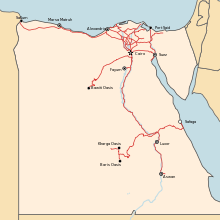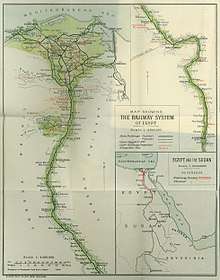Transport in Egypt
Transport in Egypt is centered in Cairo and largely follows the pattern of settlement along the Nile. The Ministry of Transportation and other government bodies are responsible for transportation in Egypt, whether by sea, land or air.
| This article is part of a series on |
| Life in Egypt |
|---|
 |
| Culture |
|
| Society |
|
| Politics |
|
| Economy |
|
Egypt portal |
With regards to rail, air and waterway travel, the main line of the nation's rail system follows along the Nile river and is operated by Egyptian National Railways. In addition to overseas routes, Egypt Air provides domestic air service to major tourist destinations from its Cairo hub. The Nile River system (about 1,600 km or 1,000 mi) and the principal canals (1,600 km.) are important locally for transportation. People still travel via the Nile, mainly between Cairo and Aswan. The Suez Canal is a major waterway for international commerce and navigation, linking the Mediterranean and Red Sea. Major ports are Alexandria, Port Said, Damietta on the Mediterranean and Suez and Safaga on the Red Sea.
With regards to driving, Egypt has one of the highest incidents of road fatalities, per miles driven, in the world.[1] The badly maintained road network has expanded rapidly to over 21,000 miles, covering the Nile Valley and Nile Delta, Mediterranean and Red Sea coasts, the Sinai and the Western oasis. Traffic rules are routinely ignored by impatient drivers.[1][2]
Road system
.jpg)
Two routes in the Trans-African Highway network originate in Cairo. Egypt also has multiple highway links with Asia through the Arab Mashreq International Road Network. Egypt has a developing motorway network, connecting Cairo with Alexandria and other cities. Though most of the transport in the country is still done on the national highways, motorways are becoming increasingly an option in road transport within the country. The existing motorways in the country are:
- Cairo - Alexandria Desert Road: It runs between Cairo and Alexandria, with an extension of 215 km, it is the main motorway in Egypt.
- International Coastal Road: It runs from Alexandria to Port Said, along the Northern Nile Delta. It has a length of 280 km. Also, amongst other cities, it connects Damietta and Baltim.
- Geish Road: It runs between Helwan and Asyut, along the Nile River, also connecting Beni Suef and Minya. Its length is 306 km.
- Ring Road: It serves as an inner ring-road for Cairo. It has a length of 103 km.
- Regional Ring Road: It serves as an outer ring road for Cairo, also connecting its suburbs like Helwan and 10th of Ramadan City. Its length is 130 km.
Plus, Egypt has developed an extensive system of 4-lane highways that can be classified as freeways, because they serve as normal roads and do not discriminate the traffic on it, thus rendering them slower than motorways.
Railways

The Egyptian railway system is the oldest railway network in Africa and the Middle East. The first line between Alexandria and Kafer Eassa was opened in 1854. In 2018, the system is about 5,085 km long[3] and is operated by the Egyptian National Railways. ENR carries about 800 million passengers and 12 million tonnes of freight annually.
A major investment programme was planned to begin in 2007 with the aim of modernizing the rail network and improving safety standards.[4] Trains are usually a safe means of transportation in Egypt.[1]
The city of Cairo is served by the Cairo Metro, which is run by the National Authority for Tunnels. In addition to the city of Alexandria that is served by the Alexandria Tram

Waterways
There are 3,500 km of waterways in Egypt, including the Nile, Lake Nasser, Alexandria-Cairo Waterway, and many smaller canals in the Nile Delta.
The Suez Canal, 193.5 km (including approaches), is used by oceangoing vessels, drawing up to 17.68 m of water (2011).[3]
Pipelines
As of 2018 the information in the CIA World Factbook states the following regarding Egypt's pipelines: "condensate 486 km; condensate/gas 74 km; gas 7,986 km; liquid petroleum gas 957 km; oil 5,225 km; oil/gas/water 37 km; refined products 895 km; water 65 km (2013)"[3][5]
Ports
Egypt has 15 commercial ports[6] and 29 specialized ports. The specialized ports include 5 tourist seaports, 12 petroleum seaports, 6 mining seaports, and 6 fishing seaports.[7]
Commercial Ports
- Alexandria Port
- El-Dekheila Port
- Damietta Port
- Port Said Port
- East Port Said Port
- Arish Port
- Suez Port
- Petroleum Dock Port
- Adabiya Port
- Sokhna Port
- Nuwaiba Port
- Al-Tour Port
- Sharm El Sheikh Port
- Hurghada Port
- Safaga Port
Merchant marine
In 2018, the number of Egypt's sea vessels, according to the CIA World Factbook is 399 as follows:
- bulk carrier: 14
- container ship: 8
- general cargo: 33
- petroleum tanker: 36
- Other: 308 (2017)
Airports
Cairo International Airport is used by numerous international airlines, including the country's own Egypt Air. In 2003, about 4.2 million passengers were carried on scheduled domestic and international flights.
Airports with paved runways
total: 72
over 3,047 m: 15
2,438 to 3,047 m: 36
1,524 to 2,437 m: 15
914 to 1,523 m: 0
under 914 m: 6 (2017)
Airports with unpaved runways
total: 11
2,438 to 3,047 m: 1
1,524 to 2,437 m: 3
914 to 1,523 m: 4
under 914 m: 3 (2013)
Heliports
- 7 (2013)
Monorail
In 2015 plans to construct two monorail systems were announced, one linking October City to suburban Giza, a distance of 35 km, and the other linking Nasr City to New Cairo, a distance of 52 km. They will be Egypt's first monorail systems.[8][9] In May 2019 the contract to build 70 four-car trains was awarded to Bombardier Transportation, Derby, England. Delivery of the trains is expected between 2021 and 2024.[10] The network is to be built by Orascom Construction and Arab Contractors.
See also
- Superjet Lines
- The Holding Company for Maritime and Land Transport
- List of bus companies in Egypt
- List of lighthouses in Egypt
References
- "Egypt" Archived 2013-10-22 at the Wayback Machine. Travel.state.gov (March 19, 2008). This article incorporates text from this source, which is in the public domain.
- "Two Ukrainian tourists killed in Hurghada bus crash". English Ahram. 12 May 2015. Retrieved 20 September 2018.
- "Africa - Egypt - Transportation". CIA World Factbook. Retrieved 16 September 2018.
- Egyptian investment will raise safety standards Archived 2007-10-23 at the Wayback Machine. Railway Gazette International August 2007.
- "Eastern Mediterranean Pipelines". Energy Egypt. Retrieved 16 September 2018.
- "Commercial Ports". Maritime Transport Sector - Government of Egypt. Egypt Government. Retrieved 17 September 2018.
- "General Statistics". Maritime Transport Services. Retrieved 17 September 2018.
- "Orascom, Bombardier to build $1.5 billion monorail in Egypt". Reuters. 3 May 2015. Retrieved 29 May 2019.
- Tawfeek, Farah (21 December 2019). "Egypt to build country's first ever monorail in Cairo". www.egyptindependent.com. Retrieved 29 May 2019.
- "Cairo monorail trains to be built in UK". BBC News. 28 May 2019. Retrieved 29 May 2019.
![]()